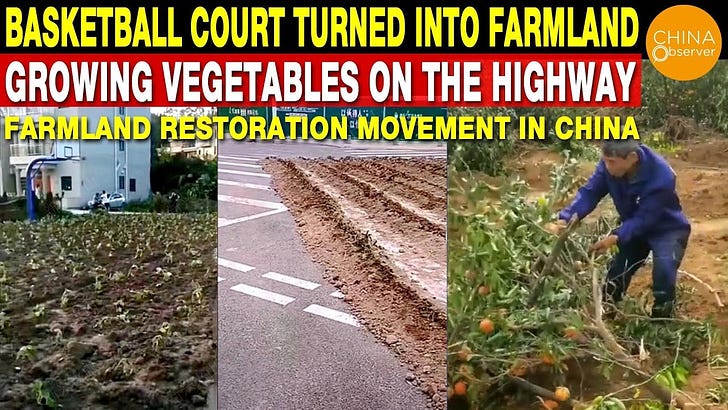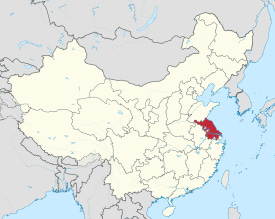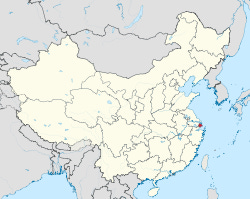The Coming Removal of the Mandate of Heaven, Part 1: Food
Why the CCP may not survive the coming crisis they have caused
Update: I’m editing this to go into better detail on what’s going on - including issues I didn’t discuss initially - and to clarify some of the ambiguity. I’m also removing the political infighting aspect as that will be the subject of the third post, which will be posted on Saturday.
Agriculture
If you have been following the news in the agricultural world, you’re likely aware of the shortages of fertilizer and seed which is effecting farmers across the world. In China’s Jilin, Heilongjiang, and Liaoning provinces, officials have reported one in three farmers lack sufficient seed and fertilizer supplies to begin planting for the optimum spring window. Missing that window will drive down the eventual yield, resulting in food shortfalls - assuming the fields in question can even be planted in time to produce a crop. According to sources within these areas, they are stuck waiting on seed and fertilizer which have been imported to China from overseas - and which are stuck in the cargo ships sitting off the coast of Shanghai.
China’s official state-run newspaper, The Global Times, has rather angrily denied these reports - along with all other reports of food insecurity due to food production shortfalls.
Meanwhile, in a repeat of Mao’s command to engage in backyard production of steel, CCP officials throughout China have begun transforming basketball courts and roads into cropland.
This is unlikely to have any real effect, and doesn’t change the fact Chinese farmers are roughly 1/40th as productive as South Korea, and the children of elderly farmers are rapidly abandoning China’s rural villages in favor of moving into the cities where they can live and work as illegal internal migrants in the hopes of making enough money to provide for their elderly parents.
Livestock
Ironically, China’s issues with outbreaks of African Swine Fever - colloquially referred to as Pig Ebola - and the subsequent culling of half the Chinese swine herds may actually have helped China weather the food export bans from both Ukraine and Russia. China typically imports 2 million tons of corn from Ukraine, most of which is then used to feed the pigs who make up a majority of the animal protein in the Chinese diet.
Thankfully, the pig population has rebounded thanks to intensive breeding programs by breeders, though prices are still at all time highs within China - placing it out of the hands of many of the poorest families within China.
Fishing
The situation at sea isn’t much better. Oceanographic research of the fisheries within China’s Exclusive Economic Zone - the 200 nmi (370 km/230 mi) zone extending from the coast as outlined in the Second UN Convention on the Law of the Sea - showed that as of the 1990’s, the biomass in China’s fisheries in the South China Sea had been reduced by 90%. Similar issues have been found with North Korea, where Chinese fishing fleets have so thoroughly overfished North Korean waters as to force Korean fishermen to sail to their deaths looking for food. Even with the draconian enforcement of fishing regulations, there are legitimate concerns the fisheries in these regions may ever be able to fully recover without a complete ban on fishing within Chinese water.
Chinese fishing companies have reacted to this by heavily funding large fishing fleets which range as far as West Africa in search of fish to feed the growing demand for seafood in the Chinese diet. Though officially capped at 3,000 vessels by Chinese law, estimates indicate that as many as 17,000 of these vessels are operating across the oceans of the world. This includes US territorial waters such as Guam, American Samoa, and Hawaii.
Squid, tuna, sharks, and forage fish are the primary sources. Sharks are used for their fins and otherwise discarded, while forage fish are ground up into pellets to be used as feed in fish farms on the mainland.
In these fleets, labor violations are common, with one crew of Indonesian sailors having described years of being kept at sea for years while they were forced to labor well after their contracts were up. When these fishermen protested over the conditions they were subjected to, they testified they were tortured by their Chinese supervisors.
The massive fleet is only able to stay at sea as long as they do through the use of dedicated tankers and refrigeration and processing ships. The refrigeration ships will cycle among the various fleets, picking up processed fish and then taking it back to the mainland to be sold in Chinese markets. Meanwhile, the tanker fleets which service these vessels have been caught attempting to help North Korea avoid sanctions on the importation of oil.
But illegal fishing, human rights violations of employees, and busting North Korean sanctions are no the only illegal actions taken by these fleets. Increasingly, China’s fishing fleets have been brought into the Chinese military as the Maritime Militia. Primarily used to stake claims to useful reefs and islands which China can turn into garrisons and missile bases, Chinese fishing vessels have attacked maritime patrol vessels of nations from Vietnam to Argentina for attempting to enforce their rights under international law. This has even extended to instances where Chinese fishing vessels have attempted to ram US Navy vessels carrying out Freedom of Navigation actions in the Strait of Taiwan.
I will go into more detail about this in a later post where I discuss China’s national insecurity with regards to their place in the international order and the rise of what is known as Wolf Warrior diplomacy.
China does, however, recognize the blow this illegal fishing has caused with the nations into whose water their fleets have encroached, so China has announced a plan to pioneer high seas fish farming. Recently, China launched the first of a new type of aquaponics vessel which will farm fish well out on the high sea. Terrestrial fish farming has also seen a massive increase due in no small part to the pollution of surface water as outlined in the next part of this series.
Logistics
However, the problem isn’t just sourcing the food. When Xi Jinping decided to chart a policy of Zero COVID, he unknowingly placed China on a collision course for disaster. For reasons I will go into in Part 3 of this series, Xi’s decision to insist on ever stricter lockdowns has now created one of the most dangerous threats to the stability of the world’s largest county since Mao’s Cultural Revolution came to an end.
To truly understand this, we need to look at information regarding the transportation of goods within China. The Chinese province of Jilin has seen truck transportation volume cut by 86%, while the city of Wuxi in Jiangsu province has seen the number of available truck drivers cut by 60%.

Truck drivers are also reportedly refusing to enter some cities due to COVID quarantine protocols which will see them placed in a quarantine camp for a minimum of 14 days at a cost of ¥3360 ($556) for the duration of that stay. This is followed by a mandatory isolation period of their own recognizance for another seven days.
This is disastrous for truckers, who usually average ¥6000 ($900) per month*, in a time when the costs they are facing are increasing dramatically.
*An earlier version of this article incorrectly stated the income figures for truckers given above was for the annual income rather than monthly. I apologize for the error.
This situation is made even worse by the actions of local Chinese officials who are so terrified of being forced to lock down the way Shanghai has they have begun locking down access to their cities or even their provinces in order to stop the spread and maintain Zero COVID.
Food is spoiling in these trucks as China’s 20 Million truckers find themselves pariahs. Truckers have been forced to live in cabs which have been ordered sealed by local authorities for days at a time, subjected to unpredictable and often seemingly arbitrary testing requirements, and occasionally even discovering access to some areas blocked off entirely.
At least one trucker has been caught on camera jumping to his death from the bridge where he spent days sealed in his cab and blocked from making a delivery of badly needed food.
Beijing has recognized this is a problem, and has decided to implement a pass system for trucks bringing badly needed supplies into the cities. However, local officials are under severe pressure to prevent positive test results from popping up in their areas of responsibility, and CCTV has been pushing discredited information regarding how the virus is spread. As such, it is entirely plausible CCP officials at the local level will ignore these passes.
Provinces and Provincial-Level Municipalities which have sealed off access to major cities, or even the entire province as a whole, include the following:
Jiangsu
A province of 85 Million people, Jiangsu is home to Nanjing - one of China’s traditional Imperial capitals - and is an important tourist destination. It has the second highest GDP in China, behind only Guangdong. Jiangsu is a major source of wheat and rice for human consumption and maize and sorghum for feedstock for livestock. Animal products include silk and fish farming. The industrial base is heavily focused on textiles, construction materials, food processing, and various consumer chemicals.
Zhejiang
With a population of 65 Million, Zhejiang is the fourth riches of China’s provinces. Zhejiang is a vital node of China’s electromechanical and automotive, textile, chemical, food, and construction industries. Zhejiang is also the center of production for low-cost, bulk manufacturing of exports for markets such as the United States. This is largely due to the Zhejiang authorities choosing to pursue a more intense liberalization and entrepreneurial economy than other mainland territories.
Shandong
Shandong has a population of 101 Million people and its GDP ranks 3rd within the People’s Republic of China. It is the largest producer of cotton and wheat in China, and home to China’s largest oil field, with a massive oil refinery complex alongside the oil field. Shandong is also China’s second largest producer of wine, and home to China’s three largest beer manufacturers. Three of China’s 15 special export processing zones are also located here - contributing to the hard currency income China needs to import important goods such as food and fossil fuels.
Shanghai
The wealthiest city in China and home to 25 Million people, Shanghai is home to China’s largest ports for both import and export. This has also resulted in China’s financial industry being located in the city, facilitating the import of hard currency - especially US Dollars - which can be used to import the staple goods mentioned above. Internally, Shanghai is also the primary node through which what little market investment in small businesses are allowed will flow. In terms of industry, China’s largest steelmill and largest shipyards are located within the city.
Anhui
China’s 11th wealthiest province with a population of 61 Million people, it is a vital source of computers, telecommunications, and automotive parts. Agriculturally, it is a dominant source for wheat, potatoes, and rice.
Hebei
Beijing’s hinterlands, Hebei has a population of 75 Million people with a GDP ranking 12th in China as a whole. It’s primarily the industrial hinterlands for Beijing, producing textiles, steel, coal, ceramics, and food processing. 40% of the population work in agriculture - with the wheat, maize, millet, cotton, and peanuts almost entirely going to feed the capital.
Liaoning
The 17th wealthiest province in China, it is home to 43 Million people. Liaoning is a top three producer of pig iron, steel, and machine tools. Mineral extraction includes important sources of precious stones such as marble, as well as oil and natural gas. Three quarters of China’s exported apples and peaches are grown here, while the fields are a major source of animal feed in the form of maize, sorghum, and soybeans.
Shaanxi
China’s 14th wealthiest population, Shaanxi’s 40 Million people are typically employed in the fields of either fossil fuel extraction and processing or the manufacture of high tech electronics. Over 50% of the aerospace R&D for the country takes place in the province, with both commercial and military production lines for aircraft located here.
Jilin
Home to 24 Million people and one of China’s poorest provinces, Jilin regularly placed 26th in terms of GDP. Primary industries here includes rice growing (typically ranking somewhere in the top third), forestry and timber products (6th most productive in all of China), and lamb and sheep’s wool. It’s also has one of the largest reserves of both oil and molybdenum within China.
Guangdong
China’s wealthiest province and the link to both Macau and Hong Kong, the 126 Million people live primarily in one of the three Special Economic Zone cities located within the province, and it accounts for a quarter of all of China’s foreign trade.
Fujian
Located directly across the Taiwan Strait from the Republic of China, Fujian has been largely neglected by the CCP due to its status as the primary staging ground for the Eastern Theater Command of the People’s Liberation Army for the eventual invasion and attempted conquest of Taiwan. Ironically, Taiwan is also the largest single investment partner for Fujian, as the KMT dominated government has spent the last few decades attempting to use economic integration to stave off the war just a little longer.
However, these are not the only issues facing China. There is more to come, with Part 2 focusing on the ongoing water crisis and Part 3 focusing on the political infighting within the CCP and what it means for Xi’s attempt to secure a third five-year term as President.















So what do you folks not understand about the Georgia Guidestones and the Globalists plan to eliminate 90% of the world population?........It has to be a slow and 'natural' looking process or the masses will revolt, as we are starting to see happen world wide with all the protests!
Please, Fertilizer to china from Russia is not a problem. The problem lies, as elsewhere stated in distribution and stupid covid policies.